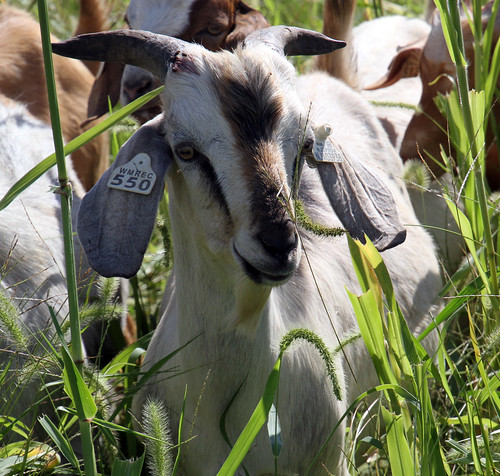For this year's Western Maryland Pasture-Based Meat Goat Performance Test, data for parasite resilience (FAMACHA© scores and anthelmintic treatments) has been summarized
During the test, the median FAMACHA© score was 2. FAMACHA© scores improved during the first part of the test, then worsened, then showed improvement on the last day of the test, despite the high fecal egg counts. Two bucks had FAMACHA© scores of 1 every time they were scored: 530 (Larr, IL) and 550 (Murphy, NJ).
FAMACHA© scores were the primary criteria used to determine the need to deworm a goat. During the test, no goat was observed to have a FAMACHA© score of 5. Only five FAMACHA© scores of 4 were detected. Goats with FAMACHA© scores of 4 or 5 are always dewormed.
Throughout the test, many goats had FAMACHA© scores of 3. If a goat has a FAMACHA© score of 3, other factors are used to determine its need for deworming. These include the Five Point Check© and Happy Factor©. The Five Point Check© includes five check points on the animal's body (eye, jaw, back, tail, and coat) and expands the utility of the FAMACHA© system by adding evaluation criteria for other parasites that commonly affect small ruminants.
The Happy Factor© is a performance-based system of evaluation. In the future, the test may place more emphasis on performance (weight gain/loss) when making deworming decisions. Other criteria which may have factored into the decision to deworm individual goats (with FAMACHA© scores of 3) include fecal egg counts (especially most recent one) and the direction of data and scores (e.g. increasing fecal egg counts and/or worsening FAMACHA© or body condition scores).
After the initial sequential deworming with albendazole, moxidectin, and levamisole, only twenty-five (25) anthelmintic treatments were administered to 18 goats during the test. A few goats were dewormed more than once. Sixty (71%) goats did not require anthelmintic treatments during the test period.
Despite the lack of clinical parasitism and need for deworming, there is likely a cost (e.g. weight gain) associated with not deworming goats with FAMACHA© scores of 3 and other indicators of sub-clinical parasitism.
Download FAMACHA© and Treatment Summary
Download FAMACHA© Treatment Rankings
During the test, the median FAMACHA© score was 2. FAMACHA© scores improved during the first part of the test, then worsened, then showed improvement on the last day of the test, despite the high fecal egg counts. Two bucks had FAMACHA© scores of 1 every time they were scored: 530 (Larr, IL) and 550 (Murphy, NJ).
 |
| Click on graph to view larger in another window. |
FAMACHA© scores were the primary criteria used to determine the need to deworm a goat. During the test, no goat was observed to have a FAMACHA© score of 5. Only five FAMACHA© scores of 4 were detected. Goats with FAMACHA© scores of 4 or 5 are always dewormed.
Throughout the test, many goats had FAMACHA© scores of 3. If a goat has a FAMACHA© score of 3, other factors are used to determine its need for deworming. These include the Five Point Check© and Happy Factor©. The Five Point Check© includes five check points on the animal's body (eye, jaw, back, tail, and coat) and expands the utility of the FAMACHA© system by adding evaluation criteria for other parasites that commonly affect small ruminants.
The Happy Factor© is a performance-based system of evaluation. In the future, the test may place more emphasis on performance (weight gain/loss) when making deworming decisions. Other criteria which may have factored into the decision to deworm individual goats (with FAMACHA© scores of 3) include fecal egg counts (especially most recent one) and the direction of data and scores (e.g. increasing fecal egg counts and/or worsening FAMACHA© or body condition scores).
 |
| All of 550's FAMACHA© scores were 1. |
After the initial sequential deworming with albendazole, moxidectin, and levamisole, only twenty-five (25) anthelmintic treatments were administered to 18 goats during the test. A few goats were dewormed more than once. Sixty (71%) goats did not require anthelmintic treatments during the test period.
Despite the lack of clinical parasitism and need for deworming, there is likely a cost (e.g. weight gain) associated with not deworming goats with FAMACHA© scores of 3 and other indicators of sub-clinical parasitism.
Download FAMACHA© and Treatment Summary
Download FAMACHA© Treatment Rankings











